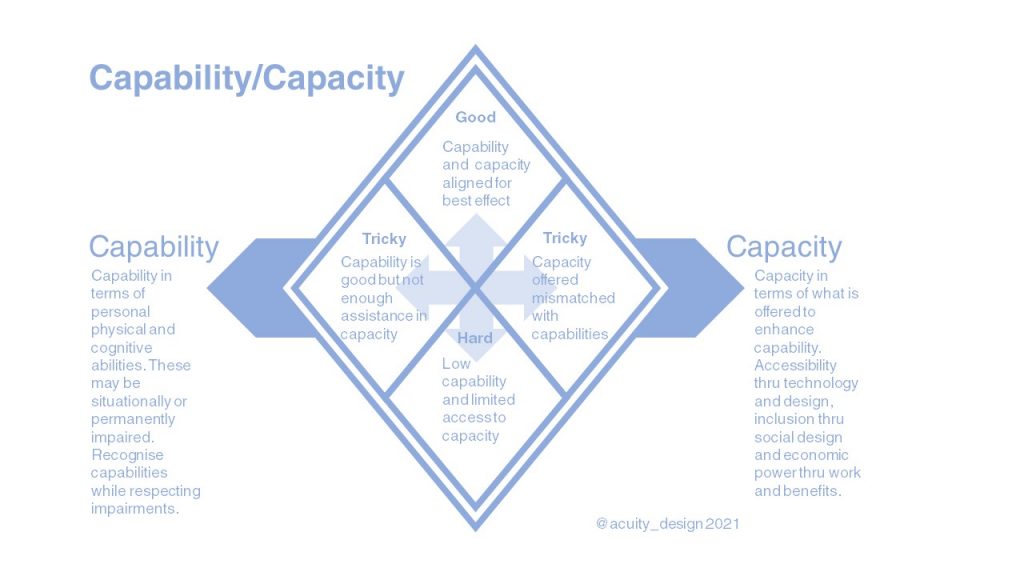Agency And Autonomy

User Experience, and design more generally, is interested in enabling the individual to do the thing they want to do. However, this can be unhelpful when discussing accessibility because it ignores much wider social and poltical ideas of personal independence and autonomy.
“Doing the thing I want to do…” is a tightly consumerist idea of being human. As long as I get what I want then I will be satisfied sounds OK unless you notice how much control is being taken away from you.
This loss of control while wants are being satisfied is fundamental problem in disability rights campaigning. The Independent Living movement was built around the loss of autonomy in so much service provision to disabled people. Living in special homes, with lives organised by professional staff, with food and goods supplied as defined by others. From the system perspective, disabled people did the things they wanted to do…but only because their autonomy was utterly ignored. Independent Living was a righteous demand for control over process, delivery and time: over a person’s life.
This is why the Intent Model of Disability matters. In both accessible design of products and in service design of public programmes (from charities, companies and government), there needs to be support for autonomy. Not merely meeting the wants of a person but ensuring they have control over process (what service is provided), over delivery (how much service and assistance is provided) and time (when services are delivered and for how long).
Every time control is removed, autonomy is restricted.
Independence is central to a person’s sense of self. It interplays with their sense of being part of society. Without autonomy, a person cannot control their position in social systems. They are merely a part (the most reductive piece of User: a unit for consumption) in the system. How people can balance their autonomy and agency in wider socio-economic systems is part of the Capability and Capacity problem.
Capability And Capacity

Accessible design needs to balance recognising capabilities, respecting impairment and understanding the offers of enhanced capacities.
Agency and Autonomy was about understanding how personal intent is more than simply getting needs met. There are issues of independence and control that need discussing.
Capability and Capacity is about thinking of personal capability and capacities offered thru services or products.
Capability
Assessing and categorising personal capability, in physical and cognitive terms, was the defining factor in the Medical Model of Disability (and it remains very strong today). Knowing capabilities, naming disabilities and freezing the sense of person in system-defined terms.
The Social Model of Disability broke the idea that people were disabled by their personal incapabilities or impairment. The disabilities were attached instead to the failures in product and service design. The inaccessibility was in the failure to recognise how design excluded. This opened up the idea of capability.
Instead of defining and freezing people to a sense of what they could not do in the eyes of the system, they could be endlessly redefining their sense of what they could be thru recognising their abilities. Particularly in cognitive terms, the problematising of divergence under Medical Model was clearly ridiculous. People could find identity and strength in what systems had diagnosed as deficiencies.
In terms of this model, Capability is therefore about recognising the individual’s sense of their capabilities, their sense of impairments and how these things can change contextually (different times of life, different place, different tasks and different social situations). Like Shoda’s idea of Contextual Personal Identity, so there are Contextual Personal Capabilities.
Capacity
The counterbalance to Capability is Capacity. If capability is about the personal sense of ability and impairment then capacity is about the personal sense of how the system provides products and services that enhance capability.
If capacity is aligned well with a personal sense of low capability then a person may now be able to do what they need. Capacity creates equity. If capacity is aligned well with a personal sense of high capability then great things can occur.
However, this is also why the diagram has two quadrants of Tricky. How capability can encounter capacity is different forms of misalignment.
Not enough capacity
The clearest failure is when not enough capacity is offered to enable a person do what they need. The lack of accessible design in a product, the inaccessibility of a place, the social exclusion of a community and the lack of funds (in salary or in benefits).
Wrong kind of capacity
Alternatively, there are situations where capacity is offered but it is misaligned with the actual capabilities of a person. Accessible design defined by a Medical Model idea of diagnosis can go badly woring because it is design that is centered around the impairment not the person. This is why good human centered design flexs capacity around shifting capabilities. Reasonable adjustment is a phrase used in accessibility regulations: making changes to meet the differing capabilities of people. However, there also needs to be the ability to customise such adjustments.
Capacity must be offered and must align with Capability.